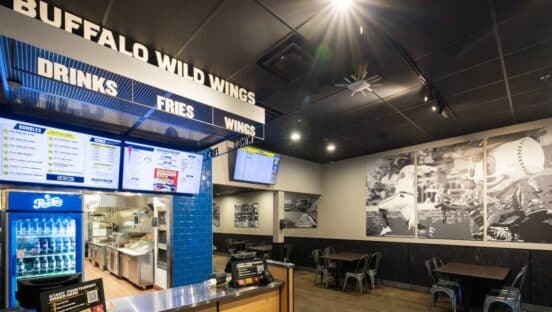The restaurant recovery is in full effect. TDn2K’s latest industry snapshot provided the most promising news in some time, as same-store sales grew 1.5 percent across the dining landscape—the best month since September 2015 based on sales growth.
And the positivity dives even deeper. On a two-year basis, April achieved slight positive growth, which has only happened once during the previous 18 months.
Is this the start of a long-term comeback?
“We are seeing an uptick in restaurant revenue beginning with the fourth quarter of last year,” Victor Fernandez, vice president of insights and knowledge for TDn2K, said in a statement. “Stronger economic conditions and high consumer confidence are certainly factors. However, this performance has to be considered against last year’s soft sales. A longer view suggests there are still significant challenges for the industry.”
READ MORE: Restaurant sales spring to life in March.
In other words: While there are uplifting factors abound, don’t get too comfortable just yet. Traffic was still down, at negative 1.4 percent during April.
“The underlying issues of restaurant oversupply and increased competition from outside the chain restaurant sector still prevail and will likely haunt the industry for the rest of the year,” TDn2K said.
Yet the same-store sales growth, which was 0.7 percentage points better than March, deserves to be appreciated. Ten of the 11 regions looked at reported positive sales during the month. The Southeast saw its sales boost 2.5 percent and traffic climb 0.6 percent. The Mountain Plains, Southwest, and Western Region were high performers as well. Florida was the lowest at 0.2 percent sales declines and a 2.9 percent fall in traffic.
Of the 196 designated market areas covered by Black Box Intelligence, 147, or 75 percent, achieved positive same-store sales growth. In March, it was only 61 percent.
Fast casual, casual dining, and upscale casual led the charge. Fast casual and casual dining continue to surge after years of tepid results. Both have year-to-date positive same-store sales growth and have shown the biggest improvement in comps in 2018 compared with the previous year, where they each experienced sales declines of 1 percent or more.
A leading factor is off-premises growth. In April, to-go, delivery, catering, and banquet sales each outperformed sales growth for dine-in business. Across industry segments, the percentage of total restaurant sales represented by these off-premises categories has been growing.
TDn2K’s data also showed robust same-store beverage sales growth. In April, beverage sales growth was the highest in more than 30 months. “This is another important metric to follow in the near future. TDn2K studies have revealed guests of both full-service and limited service restaurants really value beverages [either alcoholic for full-service restaurants or soft drinks for limited service brands] as part of their restaurant experience,” the report said.
Meanwhile, check growth continues to accelerate as well, which has lifted same-store sales for many chains in recent earnings reports. Chipotle, Wingstop, and Fiesta Restaurant Group are notable examples.
TDn2K said it has noticed, beginning in mid-2017 and continuing into 2018, a steady increase in average check. Year-over-year growth in average check was 3 percent or higher during the last two months compared with 2.4 percent for the final quarter of fiscal 2017.
“TDn2K research has shown that top performing restaurant brands grow average checks at a higher rate than underperformers. There is evidence that top performers have established a value proposition that allows them to pass along cost increases associated with higher operating expenses, especially labor,” it said.
TDn2K added that restaurants should continue to see relief from tax cuts.
“Though first quarter growth was somewhat disappointing, the reality is that the economy is growing solidly and should continue to do so,” said Joel Naroff, president of Naroff Economic Advisors and TDn2K economist, in a statement. “While wage increases are still not robust, they have been improving and the gains from the tax cuts will continue to trickle through to households for the rest of the year.”
“That personal income is rising modestly, rather than surging, could help the restaurant industry. Households have enough additional funds to spend on a night out, but not enough buy big-ticket items,” he added. Thus, we are seeing a slowdown in vehicle purchases while demand for soft-goods and eating out is holding up well. Restaurants should continue to get their fair share, if not more, of the tax cuts. However, the limited portion of the tax cuts going to low and middle-income households points to only a moderate rise in demand going forward.”
Another piece of good news perhaps? The data hinted that soaring turnover rates might have reached their peak. The national unemployment rate fell under 4 percent for the first time since 2000. TDn2K’s People Report showed, however, skyrocketing turnover rates are stabilizing and even dropped slightly.
As with sales growth, these drops in the turnover rate have to be taken in context,” Fernandez said. “Turnover falling a few percentage points does not necessarily mean we’ve reached an inflection point. Turnover rates for both management and non-management employees are still the highest we’ve seen in well over a decade. We expect turnover rates to remain extremely high in today’s low-unemployment environment. Vacancy rates also remain historically high.”
“There is definitely a reward for getting better-staffed restaurants,” he continued. “Our data shows in the first quarter of 2018, guests’ online mentions revealed that service is a more important differentiator than food. Nowadays, consumers can get a meal from many different sources. But they are saying that service is a key driver of their experience.”












